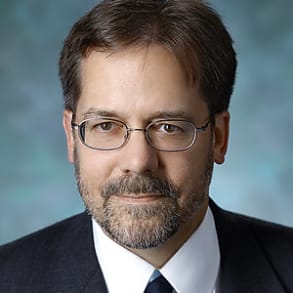Paul Fuchs, Department of Otolaryngology research director, shares the history of hearing loss research at Johns Hopkins and the advances that have been made through generous gifts from David M. Rubenstein.
the Center for Hearing Sciences, was founded in 1985 as a collaboration between biomedical engineering and otolaryngology, led by Murray Sacks and later Eric Young. With the growth of vestibular studies, it was renamed the Center for Hearing and Balance. In 1991. This research faculty made many important discoveries concerning interior and central pathway function, and that work was funded mainly by basic research grants from the National Institutes of Health. While that funding is essential to continue Discovery science, it is less certain for higher risk attempts to develop therapeutic applications of that knowledge. And this is where philanthropy can make an enormous difference. These more flexible funds enable researchers to pursue innovative strategies to understand and repair interfere dysfunction. So the first five years of Rubinstein initiatives were aimed at accelerating ongoing research projects and attracting new investigators from throughout the Hopkins community. Now in this second year program, while continuing to solicit novel research applications through a continued accelerator grants program, we have distilled our aims to focus on three strategies to apply basic discovery to novel therapies. I'm going to give you an idea of how wide a net was cast in those first five years, research projects were funded in multiple departments from several schools of the university, including, among them otolaryngology neuroscience, biomedical engineering, electrical and computer engineering, psychological and brain sciences and ophthalmology. The research projects that arose or as wide ranging as improved clinical assessment of hearing loss and vestibular disorders. And this was accompanied by the naming of the David M. Rubenstein Hearing Center in the outpatient building on Broadway. To go on to molecular controls of hair cell regeneration and synaptic connectivity in the Qalqilyah and to investigate the cerebellum is impact on hearing. In addition to these specific projects, um, several essential research cores were established functional testing, an experimental subjects, histology services and high resolution imaging. And finally, funds were contributed to the start up costs and neuroscience for a leading cellular and molecular biologists studying the inner ear. And as hoped, Dr Julie Mueller has made an enormous impact and plays a central role in our new strategic games. The David M. Rubenstein Precision Medicine Center of Excellence in Hearing will seek to apply focused therapeutic advances, toe high value targets of opportunity for treatment, single gene causes of deafness, synaptic innovation of the Qalqilyah enhanced intrinsic protective mechanisms to prevent continued damage, so there will be three strategic games. One banana medicine core will combine the expertise of surgeons scientists in otolaryngology head neck surgery with expertise in the chemical engineering Department of Hopkins to develop effective drug delivery for the inner ear to her cell repair and regeneration. This will encompass replacement of defective genes to restore function and continued efforts to drive hairstyle regeneration after loss and three original repair. After Arent innovation and re innovation will be will be pursued. Both ex vivo and in vivo and gene therapy will be used to enhance the protective different feedback from the brain. Thank you.



